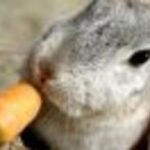If you are considering getting a rabbit as a house pet, it is important that you know how to take care of a rabbit that is kept inside. My family has had a couple of pet rabbits kept in the house and have temporarily cared for several other bunnies in our home. I will share some tips on how to take good care of rabbits that are kept inside.
Household Dangers. One of the most important points I want to make is about common household dangers for a rabbit that you need to be aware of.
The first is electric wires. Rabbits love to chew and actually need to chew to wear down their constantly growing teeth. Unfortunately, to a rabbit, an electric wire is just as good as a twig when it comes to something to chew on. When you have your bunny out of the cage for some run around time, make sure your rabbit doesn’t chew on any wires. You can also buy covers to put over the wires in rooms your bunny will be allowed to run around in.
The other common household danger to rabbits is poisonous houseplants. Rabbits love to eat veggies and that houseplant looks like a good snack to him, but it could be deadly. House Rabbit Society has a list of plants that are poisonous to rabbits that I highly recommend you read. If you have any in your house, make sure they are out of your bunny’s reach or are not in a room the bunny will be allowed to run around in.
To prevent these and any other rabbit household dangers, make sure out of cage time is supervised or have a “bunny safe” room with a gate across the doorway to keep your pet safe.
Beware of Hot Weather. Rabbits can easily overheat in hot weather. If your house isn’t air conditioned, you should give your bunny a frozen water bottle or block of ice to lie against so he can cool down. On days when temperatures were going to be in the upper eighties or higher, we would give our rabbits frozen water bottles or blocks of ice. They loved frozen water bottles and would run right over to them and start to lick them as soon as we placed them in the cage. Just make sure your bunny doesn’t chew the plastic. Most don’t, but if yours does, only give your rabbit a block of ice instead of a frozen water bottle.
The Cage or Hutch. You can use an outdoor rabbit hutch as an indoor cage for your bunny, though a lot of people go for a simpler indoor cage. An indoor rabbit cage is usually all wire and metal, or wire and plastic. Some have a wire floor and a pull out catch tray or removable bottom that you place bedding in to absorb urine and odors. Others don’t have a wire floor but have a metal or plastic bottom that you put bedding in that the rabbit can actually lie in. If you want your bunny to be able to lie in bedding, then go for a cage without the wire floor. Just make sure the cage has high sides or your bunny will be kicking bedding out of the cage all of the time.
What Bedding to Use. As with many other exotic pets, cedar and pine beddings are not safe to use for rabbits. The aromatic oils are toxic to rabbits, raising their liver enzymes, and can cause death. Aspen bedding is safe to use and is my preferred choice. Place the aspen bedding in the bottom of the cage or the catch tray to absorb urine and control odors. Many people litter box train rabbits that are kept inside as house pets. If you litter train your bunny, use the aspen bedding in the litter box as well.
Cleaning the Cage. Clean out soiled bedding as needed and thoroughly clean out and wash the cage with warm water once a week to help control odors. If you litter box train your bunny, you shouldn’t need to clean the entire cage out as often, just keep the litter box cleaned and rinsed out often and clean the cage as needed. We had a bunny that was litter box trained and my girls cleaned his litter box almost every day and the cage as needed.
What to Feed Your Rabbit. Many people think that pellets are supposed to be the main food for a rabbit, but that is incorrect. The most important part of your rabbit’s diet is unlimited hay available at all times such as timothy, oat, or grass hays. The next is raw vegetables such as carrots, celery, brussel sprouts, green peppers, collard and mustard greens, pea pods, and romaine (not iceberg) lettuce. The third part of your rabbit’s daily diet is pellets. It is recommended that you only feed about 1/2 cup of pellets a day for every six pounds that your rabbit weighs. Quality pellets should have at least 18% fiber. It is suggested that you buy no more than six weeks worth of pellets at a time to maintain freshness.
Fruit is considered a treat, not a part of a rabbit’s daily diet. You should only give your bunny very little fruit, especially of very sugary fruits such as grapes. Any other rabbit treats should also be given sparingly.
This diet varies, especially for young rabbits, according to age. For detailed information on what to feed a rabbit according to age, I suggest you visit House Rabbit Society. They also have lists of vegetables and fruits you can feed your rabbit.
It is important that you give your rabbit fresh, cool water every day and twice a day in warm or hot weather if your house isn’t air conditioned.
A Chew Block is a Must. Since rabbits’ teeth grow their entire lives, make sure your bunny has a rabbit safe chew block or toy to gnaw on. You can easily pick up a safe chew block or toy at your local pet store. It’s not safe to give your rabbit any old piece of wood or twig to chew on as it may contain chemical treatments or pesticides that can be poisonous to rabbits.
Enjoy your pet rabbit and take good care of him so he can enjoy a happy, healthy life!
Related Content:
Can You Keep Rabbits Together in the Same Cage or Hutch?
Sources:
House Rabbit Society




